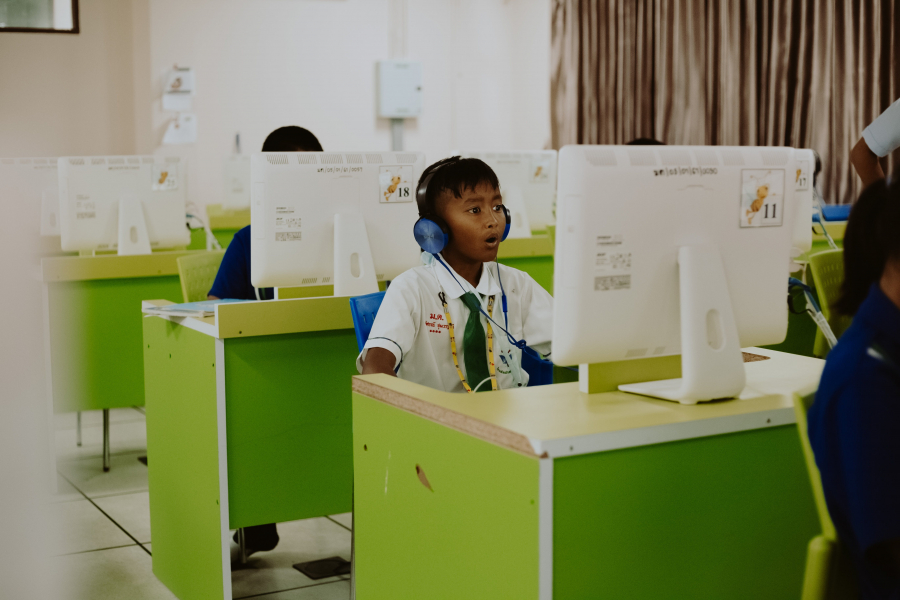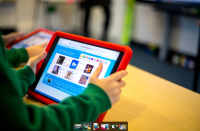Education, an ever-evolving realm, is witnessing a transformation that is both profound and exhilarating. Gone are the days when learning was confined to the four walls of a classroom, a place where knowledge was dispensed in a one-directional flow from teacher to student. Today, we stand at the cusp of an educational revolution, one where technology is not just an accessory, but a pivotal player in reshaping how we think about, engage with, and ultimately understand learning. This revolution is not just about the latest gadgets and gizmos; it’s a fundamental shift in the educational paradigm.
As we delve into this journey, we will explore various facets of how technology is redefining education. From bridging educational disparities to introducing innovative teaching methodologies, from navigating the challenges of integrating technology in schools to harnessing the power of data for decision-making, this exploration is a tapestry of insights, statistics, and expert opinions. It’s about understanding the dynamic interplay between technology and education and how this synergy is crafting a future that is more inclusive, interactive, and insightful.
In each section, we will unravel the threads of this transformation, weaving together a narrative that not only enlightens but also empowers educators, students, and all stakeholders in the educational ecosystem. So, let’s embark on this journey together and discover how technology is revolutionising education and shaping the future of learning.
Bridging the Gap: Technology as an Equaliser in Education
In addressing educational disparities, technology emerges not just as a tool, but as a bridge over the vast chasms of inequality. Michael Trucano, a voice of authority from The Brookings Institute, captures this sentiment eloquently: “In a world experiencing a global learning crisis, where as many as 70 percent of 10-year-olds in low- and middle-income economies can’t read and understand a basic text, over 244 million children and youth are out of school, and there is a projected global teacher shortage of almost 70 million teachers by 2030, a new wave of AI-enabled educational technology innovations can’t come too soon.” His words are a stark reminder of the urgent need for technology in democratising education.
This democratisation is not just about access, but about creating equal opportunities for quality education. Digital platforms, online resources, and AI-driven tools are breaking down geographical, financial, and societal barriers, offering a beacon of hope where traditional systems have faltered. It’s a narrative of change, where technology is not merely an aid, but a fundamental catalyst in reshaping the educational landscape to be more inclusive and equitable.
Innovative Teaching Methods: Beyond Traditional Classroom Boundaries
The realm of teaching is undergoing a seismic shift, moving away from traditional pedagogies to embrace methods that are as diverse as the students they aim to teach. Rajeev Ranjan, Founder and CEO of School Education, puts it succinctly: “Technology is revolutionizing education, fundamentally changing how students learn and teachers instruct.” His statement is backed by compelling statistics: a staggering 89% of K-12 teachers are now incorporating educational technologies in their classrooms, signalling a transformative trend in teaching methodologies.
These technologies are not just changing how teachers teach, but also how students learn. Interactive tools, virtual labs, and digital collaborative spaces are fostering a learning environment that is dynamic, engaging, and tailored to the diverse needs of students. It’s a paradigm where learning is no longer passive but an active, immersive experience. This shift is not just about keeping up with the times; it’s about reimagining education in a way that resonates with a generation for whom technology is a native language.
Challenges and Opportunities: Integrating Technology in Schools
While the integration of technology in education opens new horizons, it is not without its challenges. David Moinina Sengeh, Chief Minister for the Government of Sierra Leone, highlights a critical aspect often overlooked: “There is a gap between the expected benefits of technology on education management and their realization. Seemingly trivial issues such as maintenance and repair of infrastructure can be ignored or underestimated.” His insight sheds light on the practical hurdles that schools face in making technology an integral part of education.
Moreover, the conversation around technology in education isn’t just about infrastructure. It extends to its application in pedagogy. As Dr. Vaughan Connolly, a teacher and educator in discussion with the University of Cambridge, wisely points out, “The question is not whether to use ChatGPT in schools, but how to do so safely, effectively, and appropriately.” His statement encapsulates the broader challenge: the need for schools to not only adopt technology but to do so in a way that is beneficial, secure, and conducive to learning. It’s about finding that delicate balance between embracing innovation and ensuring that it aligns with educational goals and ethical standards.
The Power of Personalisation: AI in Education
The surge in AI’s role in education is not just a trend; it’s a transformative force. The AI education market, predicted to reach $20 billion by 2027, is a testament to its growing impact. AI’s prowess in personalising education is particularly noteworthy. As Meehirr K, an author for eLearning Industry, articulates, “AI can automate the assessment process and provide timely, personalised feedback to students. This helps students identify their areas of improvement and provides targeted suggestions for further learning.” This ability to tailor learning experiences to individual needs is one of the most powerful aspects of AI in education.
AI tools, such as AI quiz generators and question generators, are revolutionising how assessments are conducted. These tools not only automate the creation of quizzes but also adapt to the learning pace and style of each student, offering a more personalised and effective learning experience. This personalised approach is pivotal in a world where education is no longer a standard solution but a diverse and dynamic ecosystem catering to varied learning styles and needs.
Data-Driven Decision Making in Education
In the realm of education, the role of data has become increasingly pivotal. According to a recent Forbes survey, an overwhelming 90% of higher education leaders believe that data-driven decision-making is crucial for institutional success. This statistic underscores a fundamental shift towards a more analytical approach in managing educational institutions. The insights gleaned from data are not mere numbers; they represent a deeper understanding of student needs, educational outcomes, and the effectiveness of teaching methodologies.
An article by EdExec sums up the potential of this approach: “Data-driven decision making can help identify areas where students are struggling, address equity issues, and ensure effective resource allocation, leading to improved student outcomes and more informed decision making.” This perspective highlights how data can be a powerful tool in enhancing the quality of education, offering a roadmap for educators and administrators to navigate the complex landscape of teaching and learning.
Empowering Teachers with Tech Tools
The empowerment of educators through technology is a critical aspect of the educational revolution. The Programme for International Student Assessment (PISA) reveals a telling statistic: 53% of teachers believe that increasing students’ access to individual computers makes teaching easier and more effective. This insight reflects a growing recognition of the role of technology in enhancing teaching methodologies.
In Europe, initiatives like the SELFIE tool for TEACHERS, developed by the European Commission, are exemplifying this trend. This tool is designed to help educators assess their use of technology and find ways to integrate it effectively in their teaching practices. It’s a resource that underscores the commitment to not only equip classrooms with technology but also to empower teachers to use these tools to enrich the educational experience. These efforts signify a broader movement towards a more tech-savvy and empowered teaching workforce, capable of leveraging technology to foster a more engaging and impactful learning environment.
Navigating the Digital Transition: Challenges for Institutions
The shift towards a digitally integrated educational system is not without its hurdles, especially at the institutional level. Mark Buzinkay, in his commentary for Identec Solutions, sheds light on a critical challenge: “A notable lack of professionals with the necessary expertise for digital transformation often exists, presenting a talent challenge for organizations.” This statement encapsulates a key obstacle many institutions face: the scarcity of skilled professionals adept at managing and facilitating the digital transition in education.
This challenge is multifaceted, involving not just the technical aspect of digital transformation but also the need for a cultural shift within educational institutions. The process requires a comprehensive strategy that encompasses training educators, updating curricula, and investing in sustainable technology infrastructure. It’s a journey that calls for a nuanced understanding of both the potential and the pitfalls of integrating technology in education, ensuring that digital tools enhance rather than hinder the learning process.
Future Skills: Preparing Students for a Digital World
As we look towards the future, the role of education in preparing students for a digital world becomes increasingly paramount. The landscape of work and life is continually reshaped by technological advancements, and the skills required for future success are evolving rapidly. Education systems around the globe are tasked with not just imparting knowledge, but also with equipping students with the skills to navigate and thrive in a digitally driven world.
This imperative goes beyond teaching technical skills; it’s about fostering adaptability, critical thinking, and digital literacy. It involves creating learning environments that encourage innovation, problem-solving, and a lifelong learning mindset. As technology continues to permeate every aspect of our lives, the goal of education must be to prepare students not just for the jobs of today but for the challenges and opportunities of tomorrow’s digital landscape.
Sponsored Content


















